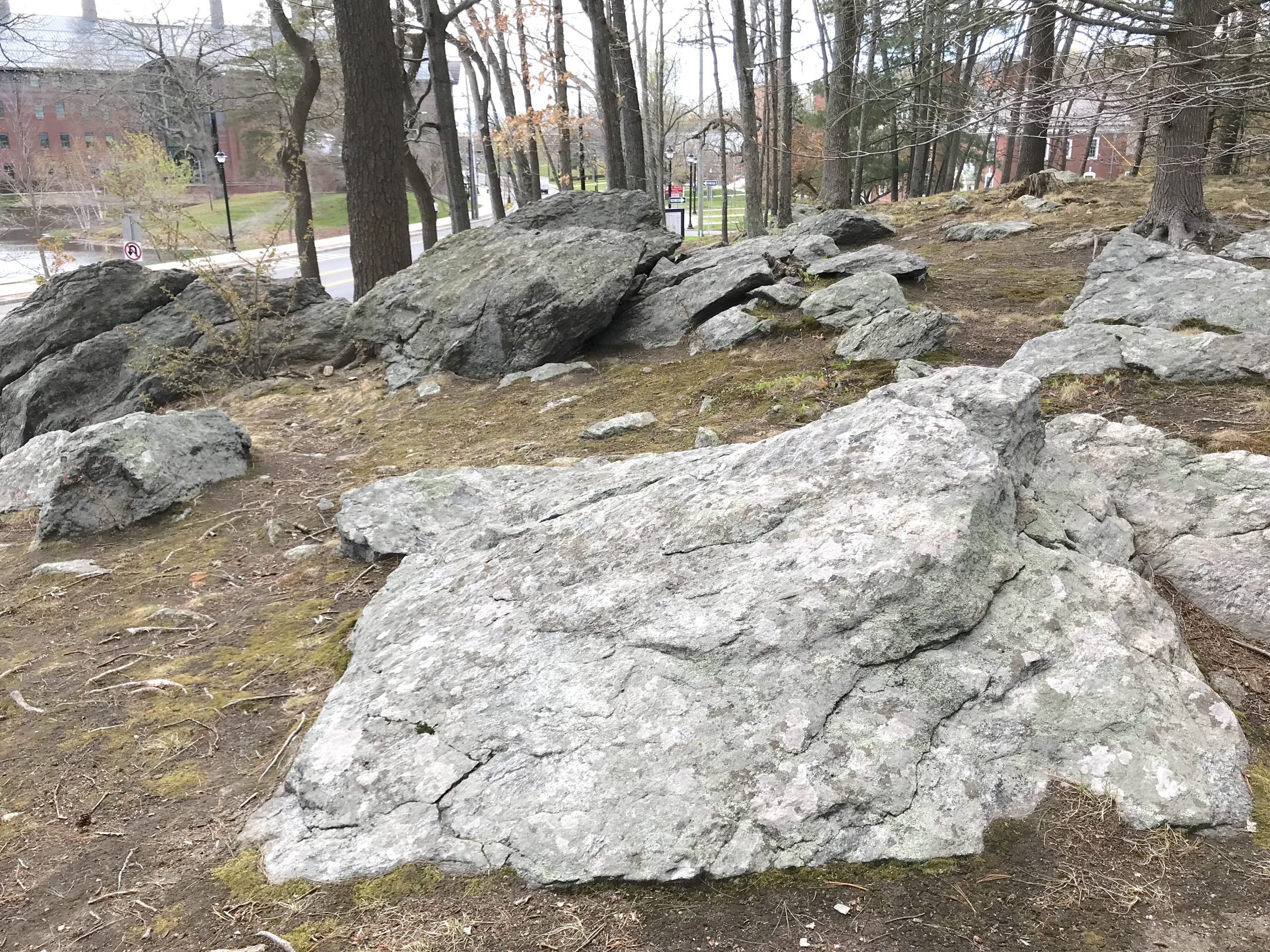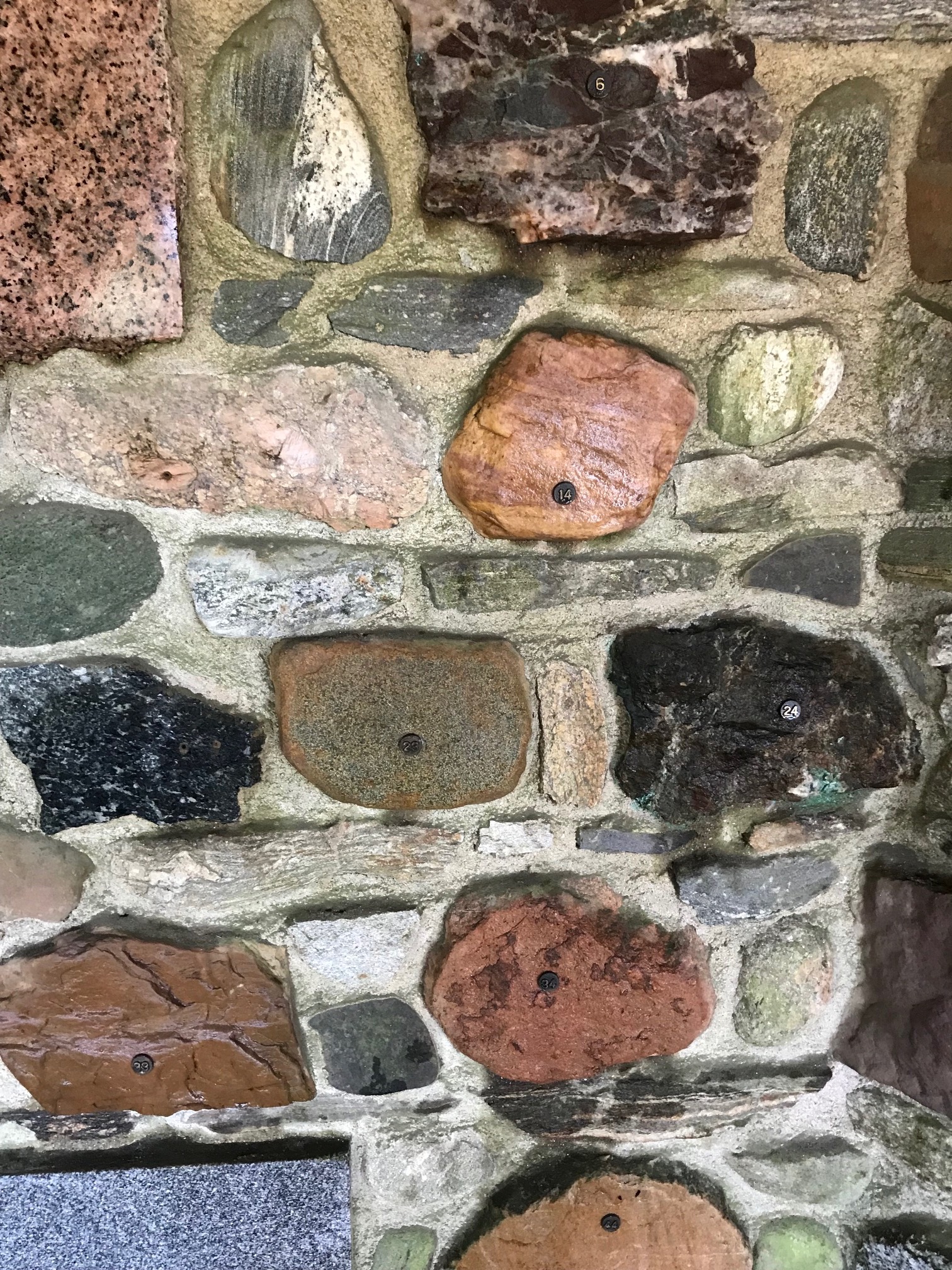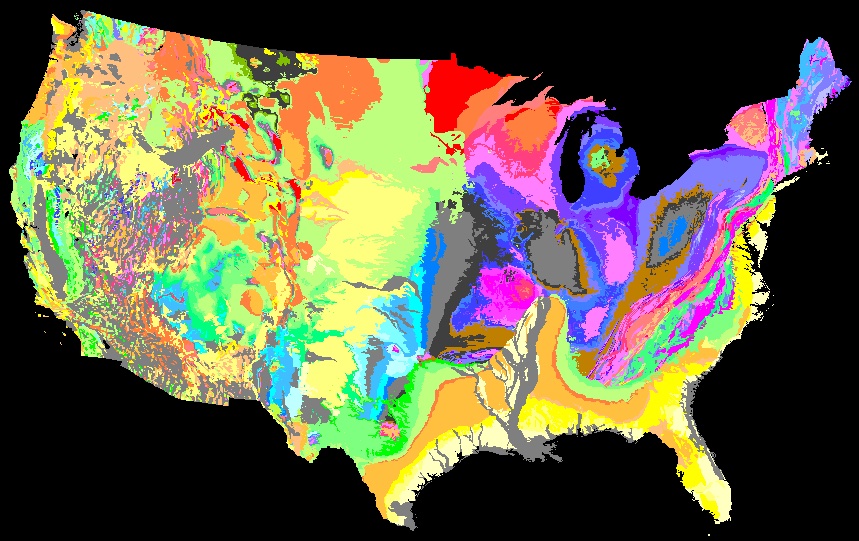The Stone Pavilion Project
One Earth
Aerial Photograph

Three Scales
The stone pavilion is more than a building. There are three essential elements, the setting, the building, and the exhibit, each with its own corresponding scale:
-
Setting - Local Scale -- The pavilion is built on in situ bedrock and is crowded by large glacial erratics of the same local lithology. One of the boulders is larger than the pavilion.
-
Building - State Scale - The exterior walls and columns of the pavilion are built from an unsourced collection claimed to be from all 169 towns and 8 counties of the state.
-
Exhibit - National Scale - The interior walls exhibit a national collection of 50 stones, one from each of the United States. Each of these is identified by a numbered brass tag that corresponds to the number on a brass plaque listing all 50 states.

The Setting
The stone pavilion rests on the highest point of an east-west trending, asymmetric bedrock ridge overlooking North Eagleville Road. The steeper southern slope is a bedrock scarp about 20 feet (7 m) high that required a stairway for access. The gentler, northern slope is thinly mantled by loose, stony glacial till. West of the pavilion, the ridge is nearly covered with large, glacially transported rock slabs. Some of these may have been dumped here after having been cleared from land to the east of the pavilion. To the east, on the lawn of the church, no bedrock is exposed and the rock slabs are absent.


Locally the lithology is a banded gneiss of light- and dark-colored bands. It's mapped as the Hebron Gneiss on the state geological map and described as, an "interlayered dark-gray schist and greenish gray, fine- to medium-grained calc-silicate gneiss." This is consistent with local observations.
The map unit is designated SOh, indicating a Silurian to Ordovician protolith of marine pelitic and clastic sediments deposited in the Iapetos Ocean, the predecessor of the Atlantic. It's part of the Merrimack Terrane, a synclinorium of highly folded rocks that were compressed in a northwesterly direction against the Central Maine Terrane and thrust below it. This occurred during an episode of mountain building known as the Acadian Orogeny that lasted about 50 million years during Mid Silurian to Lake Devonian time. The pavilion lies immediately south of a major, terrane-bounding fault.
Local foliation is north-dipping at moderate angles, creating common south-facing scarp slopes, the most dominant one being immediately below the site. North Eagleville Road was routed beneath this scarp.
In the immediate vicinity of Pavilion are large blocky fragments of rock up to 5 m across, some of which are comparable in scale to the pavilion. These are slabs of local bedrock quarried by over-riding glacial ice, transported a short distance, and deposited on a glacially smoothed rocks surface. Some of the slabs may also have been moved by humans from the north and east. From a distance, especially from the southwest, the pavilion is difficult to see amongst the many large glacial slabs, the largest and roundest of which qualifies as an erratic.
The Building

The masonry structure of the stone pavilion is built entirely of local stone mortared with concrete cement, which has held up very well. The interior ceiling is made of cement, and is uncracked and is not deteriorating. The interior width from corner to corner is 3.5 m (11.5 feet), less on the sides. The walls average about 0.45 m (1.5 feet) thick. This yields an exterior width of ~4m (13 feet)
It is reported from the 1937 Hartford Courant article that the building was composed of stones from all 169 towns of the state. This is consistent with initial observations, because there is a great variety of stone, and all of the state's major terranes appear to be represented. However, can think of no way to verify the claim of all 169 towns beyond finding the initial collection catalog because most of the stone in the masonry structure were not quarried from in situ outcrops but were milled and shaped during glacial transport.
The ice-sheet flowed over rough terrain along an ice gradient from north-northwest to south-south-east. Stones were thus progressively dispersed away from bedrock sources in in that direction, meaning a stone collected from a southerly CT town could have come from a northward widening swath of more northerly towns. Additionally nearly identical bedrock units extend along the tectonic grain into multiple towns.
Preservation of a curved exterior surface of a glacial stone or boulder (usually milled to a smooth shape) indicates that the stone was transported. The absence of cortex does not indicate lack of transport because the stone may have been broken from a larger transported boulder. This was often the case. The presence of tool marks, especially drill holes, indicates quarrying of a boulder or an outcrop. These are common on the exterior walls.
Because there are fewer towns in the state than there are stones in the masonry walls, the presence of identical stones need not indicate that a town is not represented in the collection.
The slate roof and flagstone floor of the building provides an additional opportunity to describe the role of geology in obtaining material resources. The slate of the roof provides an opportunity to discuss the regional geology of New England orogeny and its foreland basin to the west. The jointed stone of the floor provide an opportunity to discuss orogenic and post-orogenic stresses causing rock breakup.
The Exhibit

The exhibit wall consists of three segments spanning the northern half of the hexagonal building. The southern half of the hexagon is spanned by three archways supported by two additional columns. The three segments of the interior wall are separated by an angle of 60 degrees. Embedded within each wall segment are an average of 16 specimen stones and an abundance of others.
The first 48 of the specimen stones (one from each state at the time) were inserted into the exhibit in five rows, each with an average of 10 stones. Each row has a sequence from left to right. The last two stones for Alaska (#49) and Hawaii (#50) were almost certainly collected after the pavilion was built. They were skillfully embedded in the boundaries between segments in the lower left and lower right, respectively. The stone for Hawaii has a brass tag identical to those of the previous 48 tags.
Though twe haven't counted them yet, there are at least 4 unlabeled, and usually smaller, stones for every specimen stone. These constitute a separate, unstudied exhibit.

Link to all State Bedrock Maps.
Link to all Physiographic Divisions.
Initially we expected there would have been a list or inventory of all specimen stones, specifically their locations. Knowing where each specimen was collected would have allowed us to identify the rock to its specific geological formation, which would then give us the lithology and age. Knowing when it was collected, would also help us understand how the collection came together. Knowing the motives of why one specimen was collected over another would help us understand the resulting collection biases.
Alas, a search of the archives for UConn, the Connecticut Grange, and the New Britain Grange did not yield any inventory of the specimens. Nor were we successful in tracking down the family of Albert P. Marsh through the New Britain Historical Society. A request to UConn's College of Agriculture, Health, and Natural Resources (CAHNR) is underway.
The best document we have describing the materials is the May 17, 1937 Hartford Courant article that mentioned a few stones, one incorrectly. These included: "silver-bearing ore from Montana, petrified honeycomb from Iowa, a piece of petrified tree from Arizona." Though we verified the Montana and Arizona stones, the Iowa stone is definitely not a honeycomb, but a columnar favosite, a tabulate coral, a Paleozoic group that went extinct long before the emergence of honeybees. Though the article mentions "eight or 10 varieties of marble in many beautiful shades," we found no specimens of marble in the collection. More than likely, the reporter misidentified the six specimens of vein quartz as marble. Only three localities were specifically located: a "pale granite from Stone Mountain Georgia, a gray granite from "Aroostook" Maine, and a granodiorite "from the State of Washington's new $17,000,000 tunnel."
This was the sum total of information and misinformation we knew of the inventory known before this project.
To identify the specimens, were followed a series of steps, with results still in progress. First, Thorson had the lock changed and re-keyed so Pete Morenus and I could access it at any time. During the summer of 2021, Thorson cleaned nearly a century's worth of grime, dust, and surface biofilms from the specimen stones using a wire brush, water, detergent, and a weak bleach, taking special care with weaker stones. Following suggested protocol, Pete Morenus took two high-res color photos of each specimen, one of the entire stone to show its size and shape relative to the label pin, and a closeup of the lithology. These accessed via the local cloud server on One-Drive.